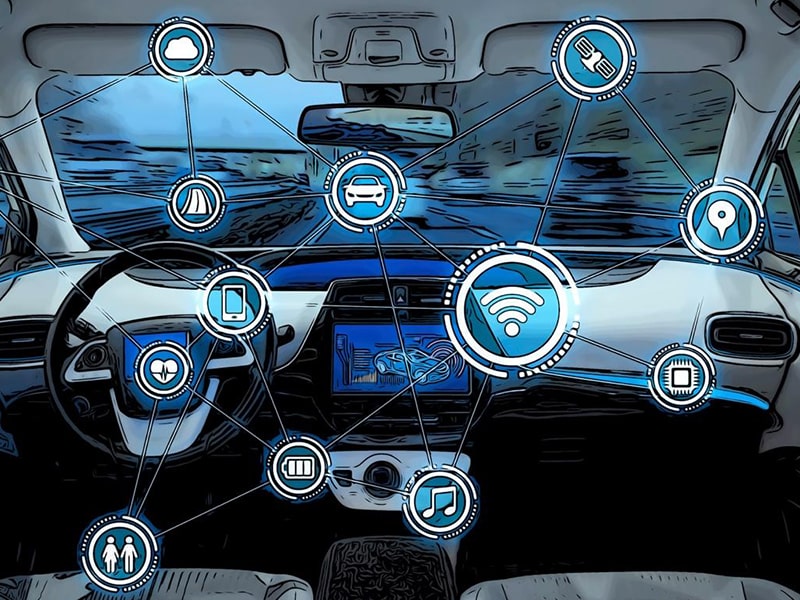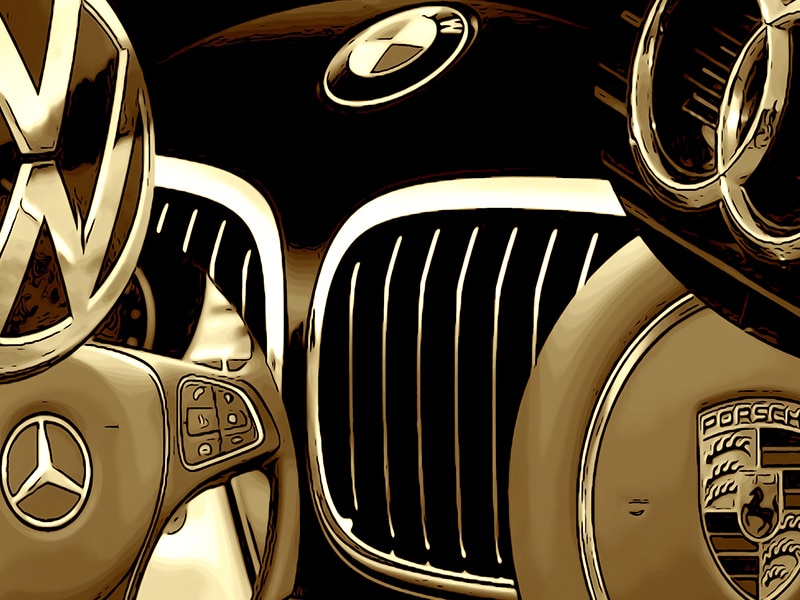
2020 was a difficult year for all of us and that includes the automotive industry globally and the proud German Automakers Volkswagen, Audi, Porsche, BMW, and Daimler. Forced production shutdowns, consumers with an uncertain financial outlook, and an unstable parts supply are just a few of the issues and challenges they faced and had to manage. During a crisis like the most severe pandemic in the last 100 years, disruptive technologies usually accelerate and that happened with battery electric vehicles in 2020 too.

Regardless if the root cause for the increased demand of BEVs can be found in Government incentives, more attractive Models, or better-charging infrastructure, it’s undeniable that they showed impressive BEV growth rates around the globe while ICE vehicle sales declined everywhere except for China. The German Automakers have declared the pandemic to be the reason for the delivery decline they suffered and their electrification strategy to be the right one and working. To prove their victory to be real they published impressive percent growth of EVs that deserve a deeper and more profound assessment.
- Daimler: +228% PHEVs + BEVS
- BMW: +31% PHEVs + BEVS
- Audi: +79.5% BEVs
- Porsche: not available
- VW Group: +214% BEV and +175% PHEVs
These are, putting BMW aside, much higher growth rates than the 36% year on year growth presented from the market leader Tesla. The numbers suggest that the German Automakers are catching up and closing the gap with the Californian Automaker.
Do they really?
This article will explain why numbers and statistics can be very misleading and if the German Automakers are growing or falling behind in 2020 and what we should expect for 2021.
The German automakers and authorities (KBA) classify electrified vehicles and hybrids as electric vehicles even though some may emit CO2. Hybrids and Plug-In EVs have a battery but they also have a combustion engine. All EV numbers published from German Automakers and the Government Authorities (KBA) include vehicles that either drive fully electric with a battery drive train or with a combustion engine that powers a battery.
Hybrids and PHEVs emit based on an actual study from ifeu (Institute for Energy and Environmental Research Heidelberg), 100%-170% incremental CO2 compared to official type registrations from manufacturers. A recent Frauenhofer ISI and ICCT study from September 2020 concludes its even 100%-600% more CO2 emissions. Ifeu, “PHEV fuel consumption and tail-pipe CO2 emissions in real-world driving, on average, are approximately two to four times higher than type-approved values”.
Considering these so far hidden and incremental emissions Hybrids and PHEVs pollute near or partly even above the levels of ICE vehicles, they should therefore not be called Electric Vehicles (EV) but what they are, vehicles with combustion engines (ICE). In Germany, you receive an incentive of €6,750 for a Hybrid versus up to €9,000 for a BEV. An incentive that helps legacy automakers to sell them. It’s totally fine to support the German automotive industry but cynical to declare them with regards to Hybrids as a measure to reduce CO2 emissions.
Germany is a country of great poets and we as a nation have never been shy to invent useful new words and terminology if needed and the intention was not always to make something clearer but sometimes to hide information. Konzentrationslager is just one example, Abschalteinrichtung (a switch-off device for cheating device) are just two examples of many I could list. A saying from the consulting business ‘if you can’t convince – confuse’ unfortunately applies for the German definition of an EV that includes a combustion engine and vehicles that drive mainly with it. Of course, there are examples of citizens that drive most of the time with the battery of their Hybrid but they are exceptions and not the average.
Indeed, Hybrids that are driven electric don’t emit CO2 but the above studies prove that just 15% of the time driving, the Buyers of company cars use the battery drive train at all. 85% of the time they use the combustion engine and emit CO2. Private owners (about 1/3 of all vehicles bought in Germany) use the electric drive train about 50% of the time. The official CO2 emission calculation of German authorities assumes an average of 75% use of the electric drive train but in reality, it’s closer to 25%. The difference between what a Hybrid emits in reality and assumed on paper is a significant 50%. Because a Hybrid emits CO2 on levels that are closer to an ICE they should not be confused or blended with zero-emission battery electric vehicles. It is a misleading practice that is unfortunately used by many if not all German Automakers, the KBA, the Government and the media.
To compare apples to apples and to avoid misleading reporting all from German Automakers available released EV data (Daimler, Volkswagen and BMW) should separate therefore BEVs and Hybrids/ PHEVs. Because the German BEVs are still delivered in small numbers German Automakers avoid to publish the data though that would allow an apple to apple comparison. The German CEOs frequently compare their companies with Tesla therefore the US manufacturer’s data is included in the following charts to make the true scale of success of the German Automotive industry in 2020 visible.
Tesla provides only the combined and blended data of Model 3 and Y as well as Model S and X together therefore the yellow Tesla bars you see in the first chart are of course larger than they would be if each of the Models could be separated. That’s not done intentionally but because it’s all the data we have. It would have been helpful to include the ID.4 2020 deliveries too but VW did not disclose that number, therefore, we can assume it to be small.
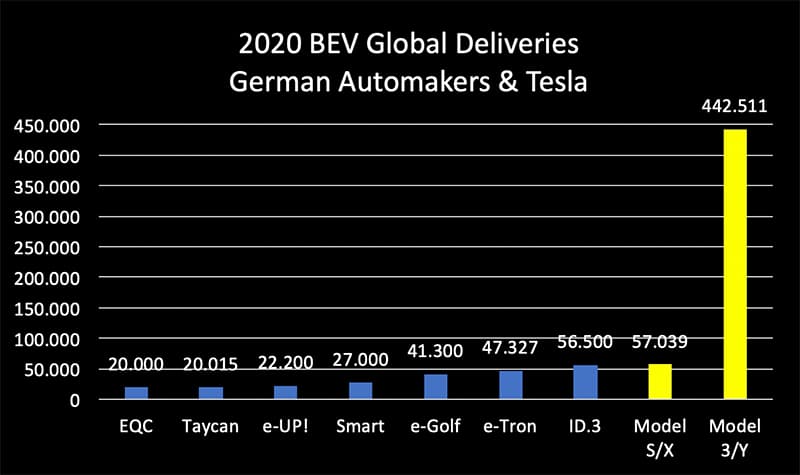
Even if the delivery numbers of the Tesla Model 3 and Y would be available in separate numbers it’s undeniable that Tesla is in a Model comparison a few times larger in unit sales than the German vehicles. The 8 years old Model S and 5 years old Model X still outsell the majority of German BEVs.
The ID.3 has been delivered since August to dealers and September to customers and only available in Europe but right from start made it on top of all German BEV Models which is a great success. Because reservations and people waiting for the car create what is called pent-up demand it is hard to determine if the strong deliveries of Q4 will continue on the same scale in 2021. VW disclosed the ID.3 2020 order volume of 68,300 units and delivery volume of 56,500, therefore it’s known that in January just 11,800 ID.3 orders have been left for 2021 and that’s a small order volume for their best-selling model.
Compared to Tesla Model 3 and Y that have open orders in the range of hundreds of thousands Tesla plays in a different league with supply as well as demand. One reason for the weak ID.3 order entry may be found in the continuing software issues of the highly-promoted vehicle and another one certainly is that it is only offered in Europe. We see this reflected in very good sales numbers of the ID.3 in some European countries compared to the Model 3. However, the ID.3 demand for 2021 is undeniably weak.
The e-Golf, although not designed as a BEV from the ground up, had a huge part of the annual BEV volume VW delivered in 2020 but its production has been stopped entirely and the Model will not be delivered anymore. That will hurt the 2021 VW BEV deliveries but hopefully compensated with the ramping ID.3 and ID.4. An ID.3 growth rate of 70% would neutralize the missing e-Golf sales but still would mean 0% growth in 2021 for both vehicles combined.
Porsche informed in 2019 that the Taycan orders are at 33,000 and for that reason increased their delivery target for the year to 30-40,000 units but delivered finally just about half of it with 20,015 units. Although this is a miss of 50% it is still a great number considering the high price for this unique sports car.
BMW does not disclose how much BEVs and i3s they sold and continue to blend hybrids and BEVs together claiming to be an EV leader. The BEV growth rate has been announced for 2020 with 13% which is compared to the low unit sales and that the e-Cooper started already selling not an impressive number in fact its possibly the lowest number of all. A decline of the i3 has been rumored too which is not a surprise given its age and that there are more attractive and newer Models in the same price range now available.
Daimler is, with the low EQC sales in 2020, a manufacturer with a strategy that relies heavily on Hybrids. They announced 5 new BEV Models for 2021 and a further shrinking organization focusing on the luxury segment. Competitors like Lucid will likely be a strong challenger for them that targets the same market the EQS has been designed for.
The next chart gives an overview of how many BEV have been sold by brand compared to the total growth or decline in percent. While all German manufacturers grew their BEV share they still all shrunk in total. Tesla instead delivered more BEVs in 2020 than all German Automakers combined.
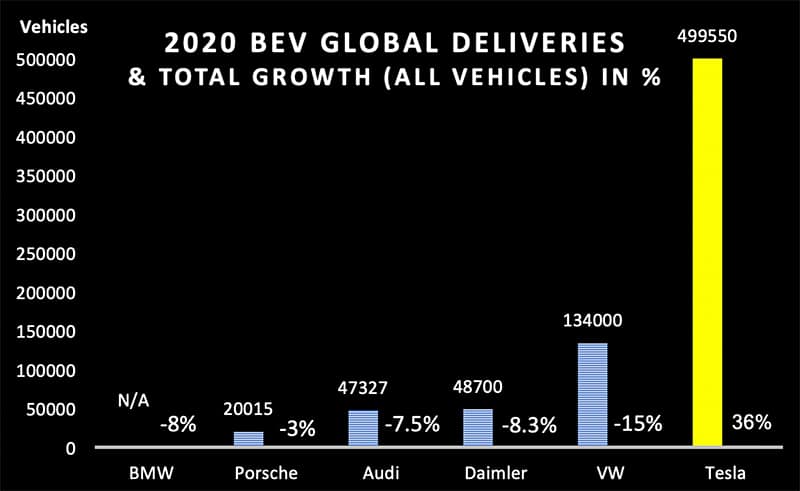
Many of the German Automakers presented proudly their BEV growth but those percentage increases are based on a small unit BEV sales in 2019. The Brand volume increase in units is as the chart illustrates compared to Tesla not impressive. Because every BEV sold is a win for climate change I applaud them for the effort and success and wish them further BEV growth in 2021. However, looking at where they stand in comparison to Tesla, the market leader who sold around half a million vehicles in 2020 and plans in total 850,000 with the ambition to achieve even more in 2021, it’s not visible that any other brand will be able to come even close. The reason for that prediction is not only the incredible demand for Tesla vehicles but the supply capacity that goes online this year with predicted more than 530,000 vehicle capacity alone in China.
The negative growth of the entire automaker group (VW -15%, Daimler -8.3%, Audi -7.5%, BMW -8%, Porsche -3%), that includes all vehicles in 2020 makes transparent that all German Automakers without exception and despite BEV and China growth are shrinking. With heavy declines of up to 30% in North America and Europe, China is the only region in which vehicles sales (of all types) increased. . That is not a one-time effect but a continuing trend in 2021 because the pandemic situation does not yet get better and consumers are asking for more good affordable BEVs that the German Automakers are struggling to deliver with a profit. Without a profit, each company has a not sustainable business model. The pressure to sell more BEVs to avoid CO2 fines is high but because the so far delivered Models sell in small numbers they won’t make a profit but increasing losses instead.
Tesla is right now the only Automaker that is profitably growing and by doing that is taking market share away that, if we believe in customer satisfaction surveys, will not come back to incumbents. With 2 large brand-new Giga Factories in Berlin and Austin to start production in 2021, the capacity is increasing exponentially while pre-orders for instance for the Cyber-Truck are in the 800,000s and the Model Y order jumped in China in one day even into the 6-digits. Remember the remaining 11,000 ID.3 orders VW has for its best-seller for 2021?! In the meantime first deliveries of the Model Y have started in China and in Europe in 6 months. All of that won’t make it easier for the German Automotive industry to grow their BEV share to the total unit levels they are used to from the time when ICE sales were still state of the art. Daimler already announced they will be in the future a much smaller company and I predict it’s only a question of time until we hear similar announcements from the other companies.
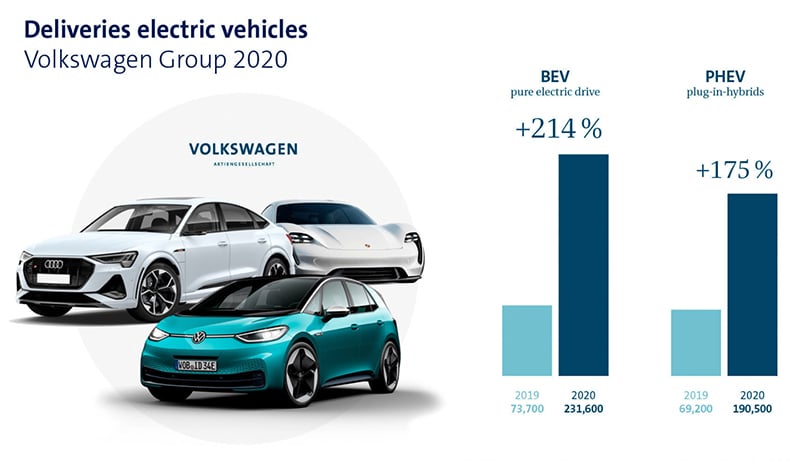
While the Volkswagen Group tends to present the EV and BEV data combined as an all brand Group many of their brands like Audi and Porsche are independent and have their own BEV production platform, technology, sales and marketing, and even their own market presence.
The VW brands include hundreds of Models to be found in Volkswagen passenger cars, Audi, SEAT, ŠKODA, Bentley, Bugatti, Lamborghini, Porsche, Ducati, Volkswagen utility vehicles, Scania, and MAN. All of them need to change to BEVs which is a gigantic challenge and effort. What Volkswagen needs right now are profitable BEV Models that sell in high numbers but what they have is not profitable Models that sell in small numbers.
The 231,600 BEVs Volkswagen as a group presented is a great and undeniable success but not a single Model they offered sold even near 100,000 units p.a.. A mass manufacturer like VW needs these top sellers to keep production and part costs low and offer vehicles for the average income household. If we add the top-selling Models VW reported together the number we get is 187,342. The 231,600 BEVs reported in the chart include 43,658 vehicles that we don’t know the brand or model name for nor if they are passenger vehicles or commercial cars. The ABT e-Transporter will be one of them with an unimpressive one of them are best-sellers, but niche products selling in small units’.
Right now, all BEVs presented from VW, Audi and Porsche likely also Daimler are not sold with a profit but with a loss, and without vehicles that sell a few hundred-thousand units per year like the Golf, VW will run into a costs and profit issue that already today is visible in the stock market valuation. Tesla is already today valued from Wall Street more than all German Automakers combined. This is a situation the Volkswagen group won’t be able to afford for very long.
The opportunity for the ID.3 and in particular ID.4 to become a best seller in the 6-digit units exists and I wish them the best of luck and success for it. For this to happen many improvements needs to be implemented because very soon there will be a new BEV Manufacturer delivering vehicles with better range, efficiency, driving assist systems and software produced in and delivered from Germans to Germans in Germany.
A difficult year for the German Automotive industry is over and an even more difficult year is ahead of them.
About the author
Alex Voigt has been a supporter of the mission to transform the world to sustainable carbon free energy and transportation for 40 years. As an engineer, he is fascinated about the ability of humankind to develop a better future via the use of technology. As a German, he is sometimes frustrated about the German automotive industry and its slow progress with battery electric vehicles which is why he started to publish in English and German. With 30 years of experience in the stock market, he is invested in Tesla [TSLA], as well as some other tech companies, for the long term.




